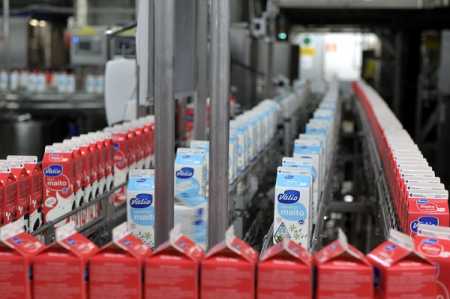|
Tue, 12 May, 2015 03:22:10 AM FTimes-Xinhua Report, May 12
This also means that the price of EU milk and dairy products will be more connected to the global market and therefore more likely to fluctuate. "A large part of the EU's additional milk production will be sold in international markets as domestic consumption increase will be relatively low," said Roel Jongeneel, senior scientist and market analyst at the Agricultural Economics Institute (LEI) of Wageningen University, a major research institution in the agri-food sector. "As the share of total milk production sold to world markets increases, so will the volatility of prices," Jongeneel told Xinhua in an interview following the abolition of the milk quota regime on April 1, which had been in place for more than 30 years. PRICE VOLATILITY Prices of EU dairy products were more volatile during the past years due to policy changes reducing export subsidies and lowering intervention prices. "More exports to countries outside the EU coupled with the adjustments in the Common Agricultural Policy (CAP) towards a very low safety net price system for dairy products means more price volatility," the Dutch agri-food expert explained. Milk production was expected to increase by around 17 percent in the next ten years in The Netherlands, and by 8 percent in the EU as a whole, the European Commission estimated. In absolute terms, EU milk deliveries were expected to grow by 12 million tonnes in the next 10 years. "Medium-term projections put the milk price at around 35 ct per kg on average in the next 10 years," said Tassos Haniotis, director of Economic Analysis, Perspectives and Evaluation in the Directorate for Agriculture at the European Commission. However, these projections were made under certain macroeconomic assumptions, he warned. "Lower oil prices, as currently forecast, could for example lead to a lower average EU milk price around 33 ct per kg," the expert in agricultural economics explained. According to his predictions, the milk price would indeed vary from this average every time there was a temporary disequilibrium between supply and demand. This could be affected by weather impacting supply, slowdown or acceleration of demand, or changes in macroeconomic conditions, he said. PRICES UNDER PRESSURE Milk and dairy product prices were under pressure since the beginning of 2015, a clear indication that EU's reliance on third markets would increase in a quota-free world. "Milk and dairy product prices are already under pressure and they will be for a period of years," said Jongeneel. "Despite the fact that global milk production has eased in March, world prices expressed in U.S. dollars remained low, because Chinese and Russian imports are still weak," said Haniotis. A recovery reported in January and February was followed by a downward trend in the EU over the last weeks, despite a weaker euro. According to Haniotis, prices might slowly recover in the coming months if China, the top dairy importer, placed larger orders. "The major uncertainty remains if and when the Russian import ban will be lifted," he pointed out. CHINA AS LARGEST IMPORTER China and other Asian countries, the Middle East and parts of Africa were expected to import EU's additional milk production in the next decade. Demand in these areas would increase as world consumption of dairy products rose by 2.1 percent annually during the same period. Population growth and changes in consumption patterns towards a higher intake of dairy proteins would be the main drivers. Most of these regions would also see an increase in their production affecting the growth rate of world imports. These were expected to rise by around 2 percent annually, 1 percent lower than during the last decade. However, according to European Commission estimates, in absolute terms, growth would be only slightly less (an additional 14 million tonnes in milk equivalent). China was expected to maintain its position as the world's largest importer of dairy commodities, accounting for around 20 percent of world imports by 2024. The annual increase in Chinese imports was, however, expected to slow down to around 3 percent a year, far lower than the annual rate of 16 percent recorded over the last decade, according to European Commission estimates. The decrease in Russian imports was expected to continue, not only as a result of the import ban, but also because the country's population was expected to decrease by 0.3 percent a year. MORE CHEESE AND MILK POWDERS A large part of the EU's additional milk production in the quota-free regime would be used to expand cheese and milk powder production, mainly skimmed milk powder and whey. "We expect an increase in the production of cheese and skimmed milk powder in the EU and in The Netherlands," said Jonegeel. "EU is more competitive in these products." Given the limited growth projections for these products in the EU's home market, a large part would be exported. In developing countries, consumption of cheese and milk powder was expected to increase by 1.9 percent and 1.2 percent annually during the next decade. As a result, the EU's market share in world trade of dairy products was likely to increase, in particular for whey (about 60 percent), cheese (close to 40 percent) and skimmed milk powder (around 30 percent), as it was pointed out in a recent LEI Wageningen report under the title "What will happen after the EU milk quota system expires in 2015?" Even though New Zealand was expected to remain the largest exporter of milk, accounting for around a third of world exports, the EU would be close behind as it strengthens its position in the world market, the European Commission has estimated. More News
|
|
Finland Times
| Saturday, 08 November, 2025 |


